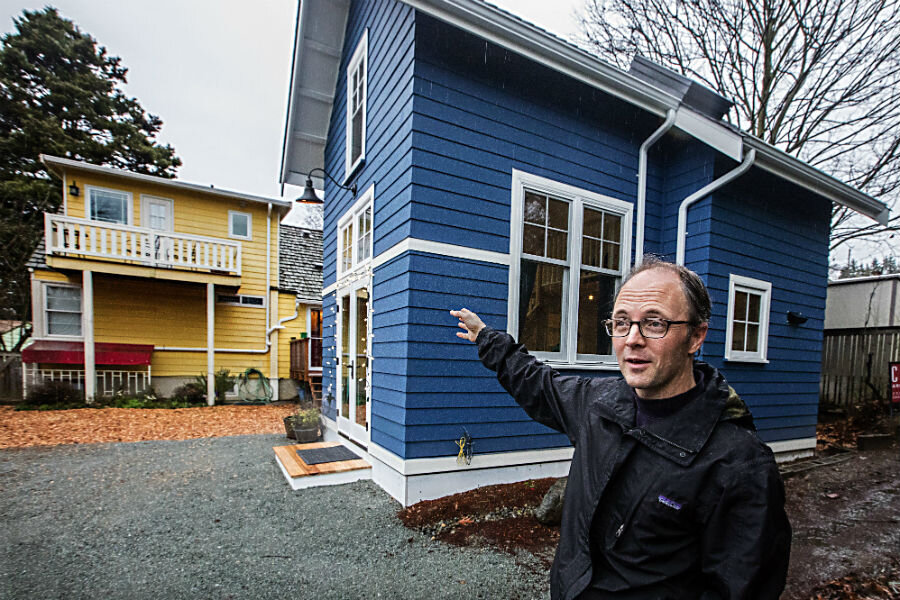Tiny-house villages: An innovative solution to homelessness?
Loading...
As the size of the average American family home has ballooned over the last half century – homes are now two-and-half times larger than they were in 1950 – so too has the homeless population. Although counts vary widely, one study estimates 3.5 million people experience homelessness in the United States each year.
Which is why more cities are turning to tiny homes as part of an innovative solution to curb homelessness. The latest city to join the tiny house movement is Seattle, which is preparing to open its first tiny house village, a collection of 14 petite homes built on a plot of land owned by a local Lutheran church.
Each 8-by-12-foot home offers residents insulation, electricity, and oil heat. A central building offers flush toilets, hot and cold water, and showers. More importantly, however, the new village offers previously homeless people dignity, privacy, warmth, and safety.
Each house cost about $2,200 to build – paid for by donations and built by volunteers – and residents will pay $90 a month for utilities. The idea is that residents will stay in these micro homes until they can transition to more permanent affordable housing.
“It’s a lot less stressful," Dennis McCrea, a volunteer helping to install the homes, and also their first resident, told a local FOX TV station. "You can think about what you have to do to move forward not where you are going to sleep every night."
With its first tiny house village, Seattle joins a national movement of micro-homes, an alternative approach to housing the homeless that's being replicated in cities across the country.
More than 3.5 million people, including 1.35 million children, experience homelessness in the United States each year, according to the National Law Center on Homelessness and Poverty.
One of the major problems plaguing this population are shortages of affordable housing. In fact, for every 100 households of renters that earn "extremely low income" (30 percent of the median or less), there are only 30 affordable apartments available, according to a 2013 report from the National Low Income Housing Coalition.
The National Alliance to End Homelessness estimates that the country needs 7 million more affordable housing units to meet homeless and low-income housing demand nationwide.
Tiny house villages, like the one in Seattle, may be part of the solution. The villages are a hybrid of two trends, notes Buzzfeed: tent cities, the homeless encampments that began in the Great Depression and received revived attention following the recession; and the tiny-home movement, a trend toward more environmentally, and socially-conscious micro homes.
The tiny house movement began in Downtown LA in the mid-1990s with Dome Village, a cluster of geodesic domes. It received national attention in 2001, when activists protested the treatment of homeless people in Portland by erecting a tent city. The tent city was eventually relocated and replaced with tiny houses. Dubbed Dignity Village, the collection of micro homes helped give rise to the idea of a tiny-house village for the homeless. Today, these villages offer small structures in which residents can sleep and find privacy, and larger communal buildings with bathrooms, kitchens, and recreational space.
Today, a number of cities across the country have experimented with tiny-house villages for the homeless, including Village of Hope in Fresno, Calif.; River Haven in Ventura, Calif.; Opportunity Village and Emerald Village in Eugene, Ore.; Quixote Village in Olympia, Wash.; OM Village in Madison, Wisc.; Second Wind Cottages in upstate New York; and Community First in Austin, Texas.
Not everyone is convinced that these micro homes are the best solution to the colossal problem of homelessness, however.
“These villages might fill a small niche but I don’t see them as a major solution to the problem of homelessness,” Alex Schwartz, a professor of urban policy at the New School in New York, told Buzzfeed.
“Not to say [such villages] are absolutely impossible” in a city like New York, “but commercially zoned land is at a premium. Multi-unit solutions [under one roof] make a lot more sense.”
In fact, finding affordable land for such tiny house villages, especially in expensive cities like New York, is a problem. The unorthodox villages may also present zoning problems in some cities, which is why some advocates suggest government housing vouchers and more public housing are a better solution.
Still, local and federal government officials are beginning to accept tiny house villages as one part of the solution to curb homelessness.
"It's certainly something that we would encourage other communities to take a look at when it comes to creating solutions for housing the chronically homeless," Lee Jones, a spokesperson for the U.S. Department of Housing and Urban Development, told Yes! Magazine. "It's a very important step in terms of the kinds of services we should be providing to people that need assistance."








